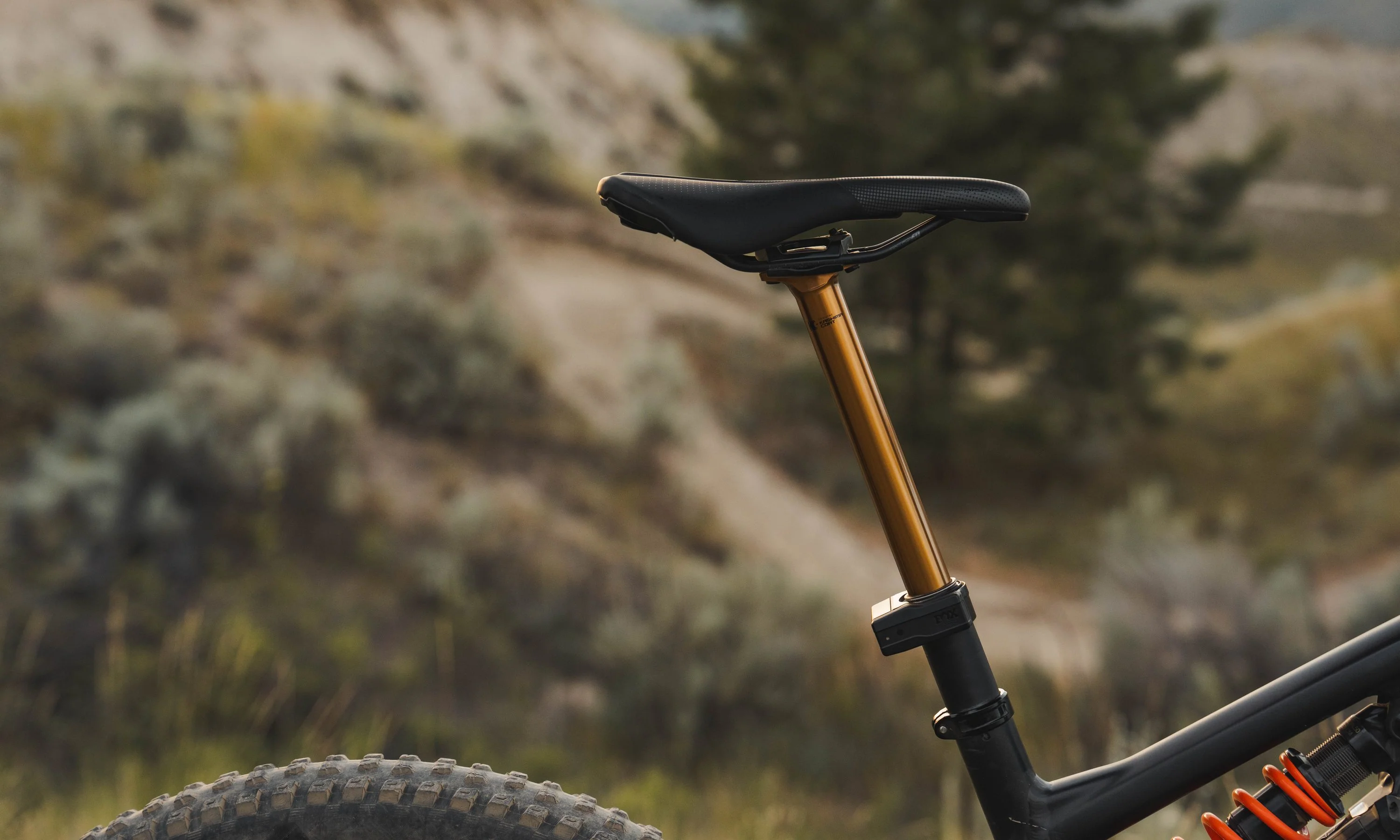Every time someone at The Pro’s Closet unveils their new bike, a crowd gathers. We’re all bike nuts here, so we love vicariously experiencing anyone's new bike day.
But then, as the bike gets pulled out of the box and the drivetrain is revealed, a division forms in the crowd. Half nod in approval. The other half start talking smack. This is tribalism. It stems from one of the greatest rivalries in cycling: Shimano vs. SRAM.
I bought a new mountain bike frame, and since I'm building it up myself, I need to choose between a Shimano or SRAM drivetrain. I’m not particularly loyal to one brand, so I took a poll of The Pro’s Closet mountain bikers to see what drivetrain they're running.
I discovered a pretty even split between Shimano and SRAM users. The most popular drivetrains are Shimano’s latest 12-speed Deore XT M8100 drivetrain, and SRAM’s 12-speed GX Eagle drivetrain.
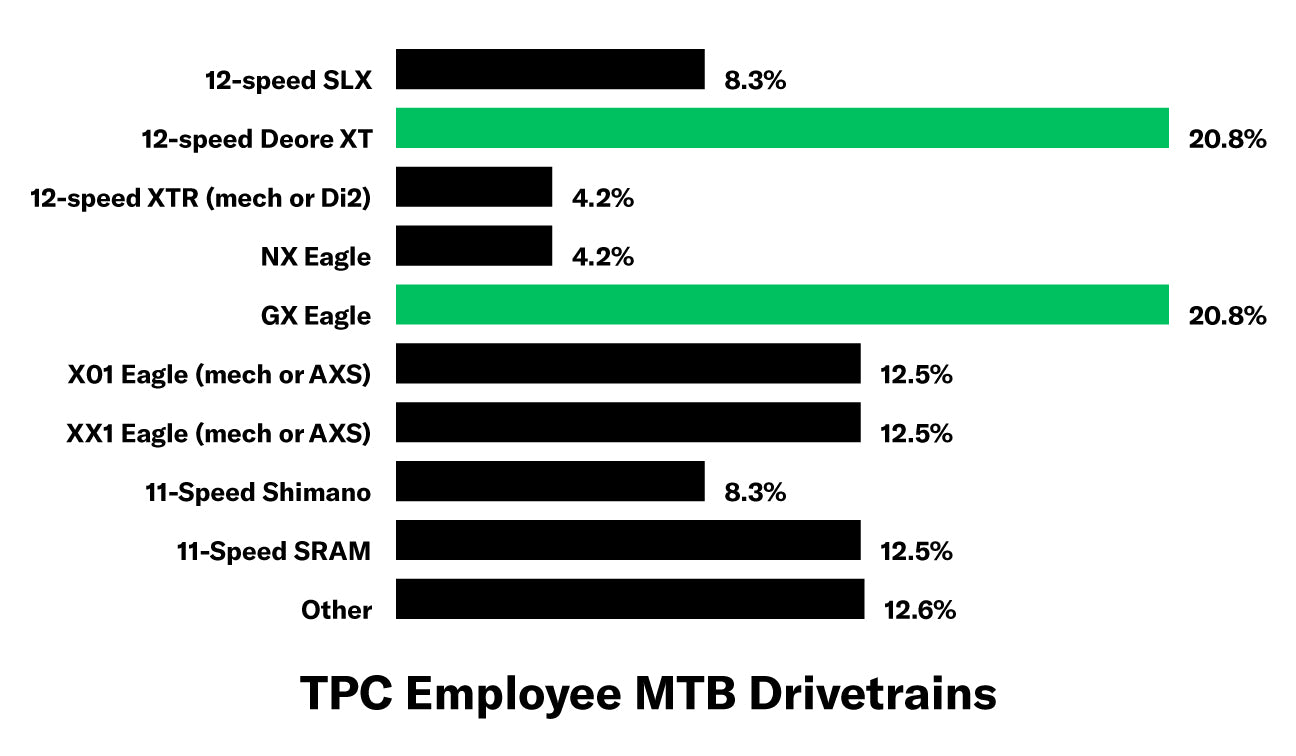
Deore XT and GX Eagle are not only popular with TPC employees, but they’re also the two most ubiquitous drivetrains in our mountain bike inventory. If you're looking for a new or used mid-range mountain bike, there's a pretty good chance it will have one of these two drivetrains.
The purpose of this piece won’t be to determine which group is “better.” Instead, it will explore some of the technical, quantitative, and qualitative differences, and why our riders choose one drivetrain or the other. Read on to see how Deore XT and GX Eagle compare.
[button]Shop Components[/button]
Contents
- Component hierarchy
- Price
- Weight
- 1x vs. 2x options
- Cassettes
- Chains and chainrings
- Rear derailleurs
- Electronic shifting
- Popularity
- SRAM SX Eagle vs Shimano Deore
- Final thoughts
Component hierarchy
|
Shimano |
SRAM |
|
Deore |
SX |
|
SLX |
NX |
|
Deore XT |
GX |
|
XTR |
X01/XX1 |
Deore XT and GX Eagle occupy the upper-to-mid level of both Shimano and SRAM’s mountain bike ranges. They aren’t as expensive or blingy as the top-tier drivetrain offerings, but they perform nearly as well and are a great option for enthusiast riders and amateur racers who want a quality groupset.
The chart above is organized from entry-level to high-end. It’s pretty simple, but when speaking to mountain bikers at TPC, I discovered that many disagree on what drivetrains are considered equivalent between Shimano and SRAM. Some were surprised that XT and GX were even considered to be on the same level. (If you feel this way, let me know in the comments!)

Group hierarchies don’t line up perfectly across brands. In particular, SRAM’s X01 and XX1 drivetrains create an interesting dilemma. Technically, X01 lies beneath XX1. It costs a few hundred dollars less and weighs a tiny bit more. But X01 is still significantly more expensive than both GX and Deore XT. As explained in an earlier GX vs. XX1 comparison, the differences between SRAM’s top two drivetrains are minimal — colors, a few bits of carbon, and some foam in the crank arms.
I find it easier to think of X01 and XX1 as two different versions of the same top-tier drivetrain, both competing with Shimano XTR. These are the drivetrains chosen by professional racers, with XX1 more often used in XC racing and X01 in enduro racing. GX is the next step down, similar to how Shimano’s Deore XT is the next step down from the more race-focused XTR group.
Price
MSRP (drivetrain only — shifters, derailleur, cassette, crank, chainring, and chain)
Shimano Deore XT: $623
SRAM GX Eagle: $545
As you can see, the Deore XT drivetrain retails for about 80 dollars more than the GX Eagle drivetrain. $80 is a pretty small difference for a full drivetrain. Of course, it’s possible to find drivetrains for below retail pricing if you search online. If you’re buying a complete bike, knowing the drivetrain's MSRP can give you a sense of how much value it adds (or detracts) from your bike.
One thing to note is that the GX retail price is for a GX drivetrain equipped with the standard aluminum GX crank. Beginning in 2020, a carbon GX crank option is available and will add $140 to the price of a GX drivetrain.
The above retail prices are noted as “drivetrain only” because Deore XT is also available as a complete groupset with brakes, wheels, and pedals. GX Eagle is only a drivetrain. SRAM has other component offerings for brakes and wheels that aren’t tied to any of its drivetrains by name.
Compared to any top-tier drivetrain, Deore XT and GX Eagle are relatively affordable. For a top-tier drivetrain expect to pay $1,300-1,500, with electronic drivetrains in the $2,000+ range. Drivetrains a step down from Deore XT and GX Eagle are more affordable at $410 for Shimano SLX and $375 for NX Eagle.
Weight
Shimano Deore XT: 1,833g
SRAM GX Eagle: 1,752g
Even if you aren’t a full-on weight weenie, you’re probably somewhat aware of your bike's weight. We weigh every component and bike we sell. Individually, Deore XT and GX Eagle components are all pretty close. On our scales, a complete GX drivetrain weighs around 80 grams less than a complete Deore XT drivetrain — a little under 3 ounces. In the grand scheme of things, that’s pretty negligible. But if you’re picky, 3 ounces could be the difference between a mountain bike that weighs over 30 pounds and a bike that’s under. There are people out there (like me) who think like that.
Notably, the new carbon GX crank adds $140, but saves an additional 80 grams over the standard aluminum GX crank, making a complete GX drivetrain with carbon crank 160 grams lighter than Deore XT.
Will this weight matter to you? That's a question you have to answer for yourself. Realistically, it won’t affect your performance, and you probably won’t be able to notice it while riding. Personally, I’m susceptible to obsessive gram-counting. If my bike is marginally lighter, it boosts my mental state and makes me feel faster. It’s silly, I know. For more information about the importance of bike weight, check out this article: Does Bike Weight Matter?
If you’re truly committed to shaving grams, you’re going to have to shell out the big bucks for XTR, XO1, or XX1. Exotic materials like carbon fiber and titanium mean these top-tier drivetrains come in around 1,500 grams, saving you around 250 grams, or about half a pound.
Deore XT and GX Eagle are 200-250 grams lighter than more entry-level drivetrains like SLX and NX Eagle, which both tip the scales at over 2,000 grams.
1x vs. 2x options
There is one thing Shimano does that SRAM doesn’t — let you shift a front derailleur. SRAM abandoned the front derailleur long ago, and 1x drivetrains have since become the standard for modern mountain bikes.
But Shimano has remained faithful and still offers 2x mountain bike drivetrains. The current cable-actuated, side swing front derailleurs are actually amazing pieces of tech. The revised cable pull makes these newer front derailleurs smoother and more efficient than the clunky, chain dropping front derailleurs of the past.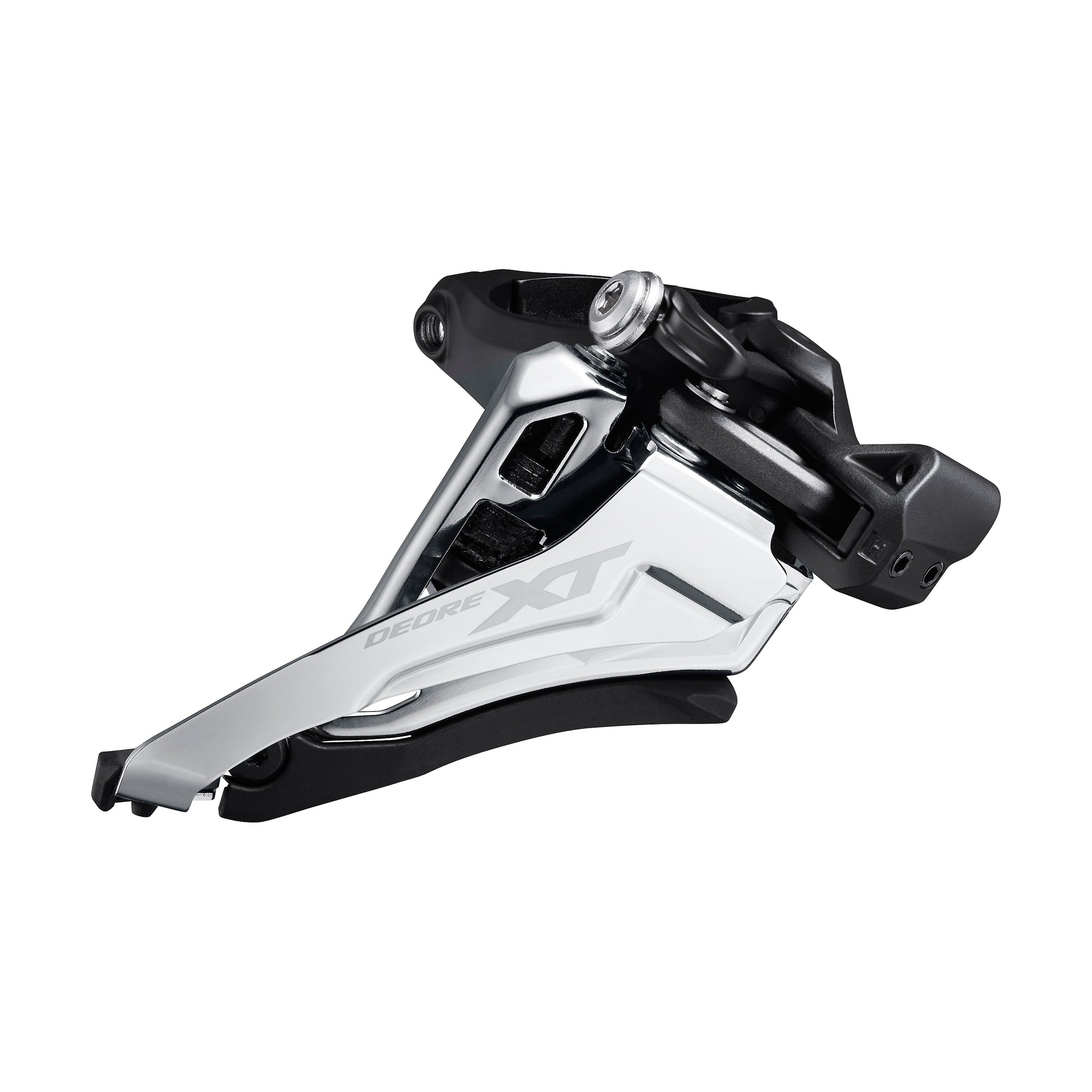
Photo credit: Shimano
Does this make Deore XT superior? Well, the mountain bike marketplace has spoken, and the vast majority of riders want a simple 1x system. Most new mountain bike frames are 1x specific and don’t even have a way to mount a front derailleur if you wanted one.
But if you’re old-school, or one of the few who want the smaller steps between gears that a 2x can offer, then Shimano is the only choice. The 2x option will add to the cost and weight of the Deore XT drivetrain.
Cassettes
In the last couple of years, an interesting little battle has waged between Shimano and SRAM over cassette teeth. When SRAM first released its 12-speed Eagle drivetrains in 2016, the 10-50t cassettes seemed comically massive. But four years later, they’ve become accepted and normal.
 The Deore XT 10-51t cassette and SRAM GX Eagle 10-50t cassette. | Photo Credit: Shimano / SRAM
The Deore XT 10-51t cassette and SRAM GX Eagle 10-50t cassette. | Photo Credit: Shimano / SRAM
Shimano lagged behind for a time, and the widest cassette it offered was an 11-speed 11-46t Deore XT cassette. But in 2018, Shimano came out swinging with its new generation of 12-speed drivetrains. Its new Wide Range, 1x specific cassettes for XTR, Deore XT, and SLX offered a 10-51t range. One tooth more!
Not to be outdone, SRAM released a new cassette in 2020 with an even wider range: 10-52t. Will Shimano and SRAM continue to duke it out over the next few years, each releasing a new cassette one tooth more than the last? I sure hope so.
How much difference does a single tooth make? Doing some basic math, there is about a 2% difference with each single tooth increase. On a 29er with a standard 32t chainring and 175mm cranks, the gear inches come out to 18.5, 18.2, and 17.8 (50-, 51-, and 52-tooth, respectively). Yes, it’s easier to climb steep grades with more cassette teeth, but those numbers are all pretty close. A good night’s sleep will probably make a bigger difference.
But, as I've said earlier, I’m neurotic enough to think 80 grams can make a difference, so I can probably convince myself that a granny gear that's 2% easier will be the difference between me cleaning a tough climb or getting off and walking.

One thing I will mention is after trying the new 10-52t SRAM cassette, the jump from the 42t to the big 52t cog is a bit more noticeable than the 42t to 50t jump on the older 10-50t cassette. It’s not bad, or clunky, but I do feel like I’m “hitting the eject button” when I shift into it. A necessary sacrifice for the ultimate granny gear and on hard rides with long and grueling climbs, I don't care. For those that do, the Shimano cassette uses a smaller and slightly smoother 45t to 51t jump for the last two cogs.
Also, because Deore XT still has a 2x option, there is a smaller, 2x compatible 10-45t cassette available called the “Rhythm Step” cassette. The 10-51t “Wide Range” cassette isn’t intended to be used with a 2x set-up because the derailleur pulley cage won’t be able to handle the chain length. Riders who don’t need a big granny gear and want tighter spacing between gears could also use the Rhythm Step cassette on a 1x set-up.
Ultimately, the cassette is a wear item. On a 1x drivetrain it will last through several chain and chainring replacements, but it will wear out eventually. If that time comes, A Deore XT cassette retails for $160 and a GX Eagle cassette for $215. That's a notable difference.
This difference in price is largely due to construction. The Deore XT cassette uses a carrier for the large black cogs, and the remaining cogs are stacked individually on the freehub with spacers. The GX Eagle cassette is one piece, constructed of multiple cogs pinned together. It’s not as sophisticated or light as the hollow one-piece X01 or XX1 cassettes, but it provides the same easy install and removal. The GX Eagle cassette construction saves about 20-25 grams over the Deore XT cassette.
Cassette freehubs
SRAM introduced its XD Driver freehub body in 2012. Shimano followed suit when it released its Micro Spline freehub body for its new 12-speed drivetrains. The XD Driver and Micro Spline freehubs have a smaller diameter, which allows wide-range cassettes with a smaller 10 tooth cog to fit. GX Eagle cassettes use XD Driver and Deore XT (M8100) cassettes use Micro Spline.
Pay attention to this if you plan on getting new wheels for your bike. You’ll need a rear hub with a compatible freehub for your preferred cassette. Currently, wheels with SRAM XD drivers are more common than Micro Spline wheels, especially in the used market. Until recently, very few brands were allowed to produce and sell Shimano Micro Spline freehubs.
In my experience, both freehubs work perfectly fine. They’re just different so the two brands can keep everything in the family.
Chains and chainrings
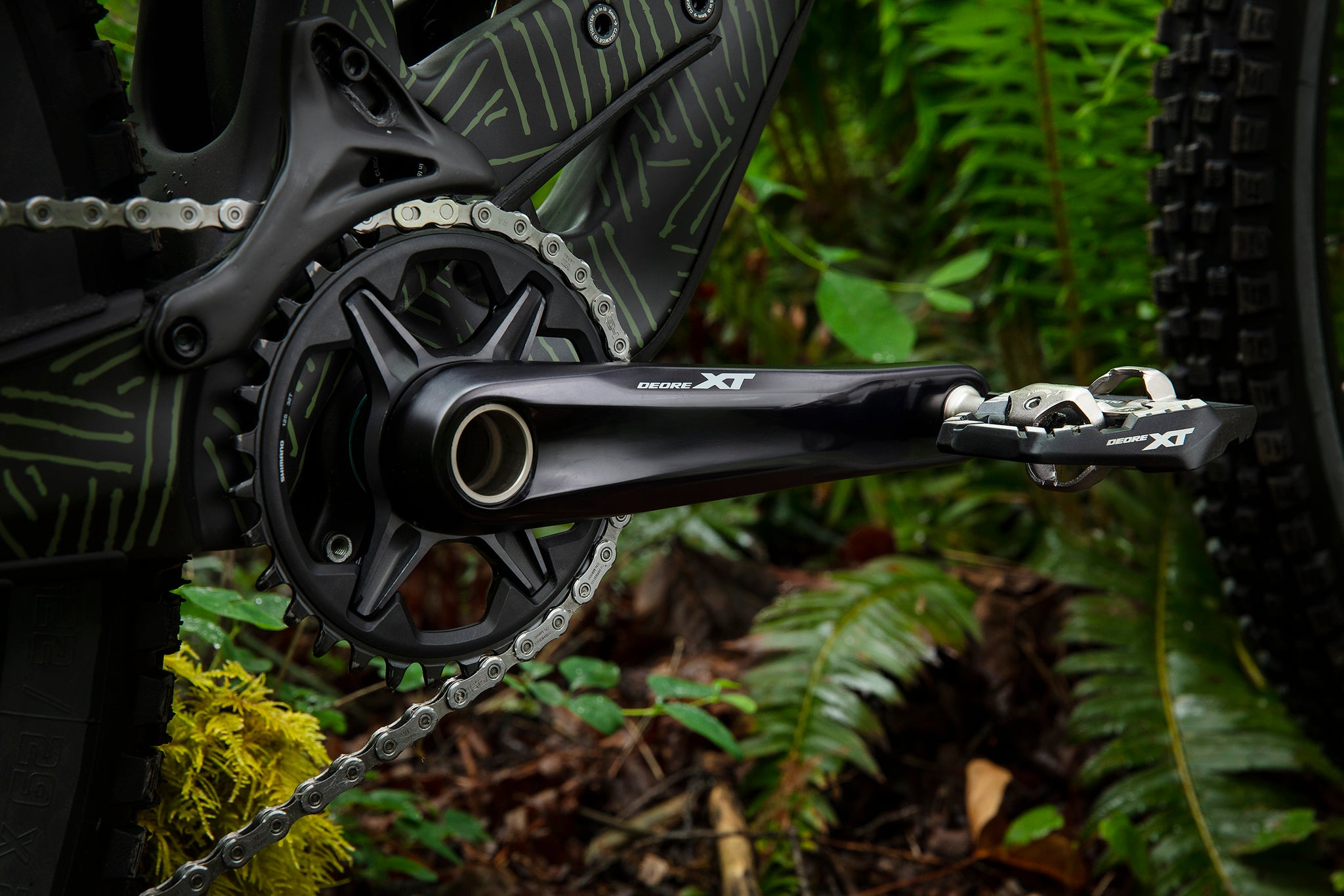 Photo credit: Sterling Lorence
Photo credit: Sterling Lorence
With new 12-speed MTB groups like Deore XT M8100, Shimano introduced a new chain with “Hyperglide+ shift technology” to improve shifting and chain retention. Unfortunately, this new chain design means the massive box of 1x chainrings I’ve collected over the years is useless. Hyperglide+ chains require chainrings using a proprietary Shimano tooth shape. Brands like Race Face and Wolf Tooth also make compatible chainrings.
Though the SRAM techs may not condone it, I like that I can use nearly any normal narrow-wide chainring. These chainrings are common and easy to find nearly anywhere. I swap chainrings a lot, but I do like the unique tooth shape of the SRAM Eagle X-Sync 2 chainrings.
Chains and chainrings are the main consumables you will need to replace regularly for these drivetrains. In terms of price and lifespan, Deore XT and GX Eagle chains and chainrings are pretty comparable. Shimano and SRAM branded chainrings retail for around $65. I find that XT chains generally run for $35-45 and GX Eagle chains for $25-40 depending on the seller. I put about 600-1,000 miles on a chainring and 1,000-1,500 miles on a chain before I change them.
If you want a super-chain for your mid-level drivetrain, I always suggest the XX1 Eagle chain. I’ve had two last to 3,000 miles and through several chainrings. No matter what Eagle drivetrain I currently have, I always upgrade to the XX1 Eagle chain.
According to this great chain article by David Rome, the 12-speed XTR chain also has great longevity, but I’ve yet to test one. It may be a good upgrade option for a Deore XT drivetrain.
Rear derailleur
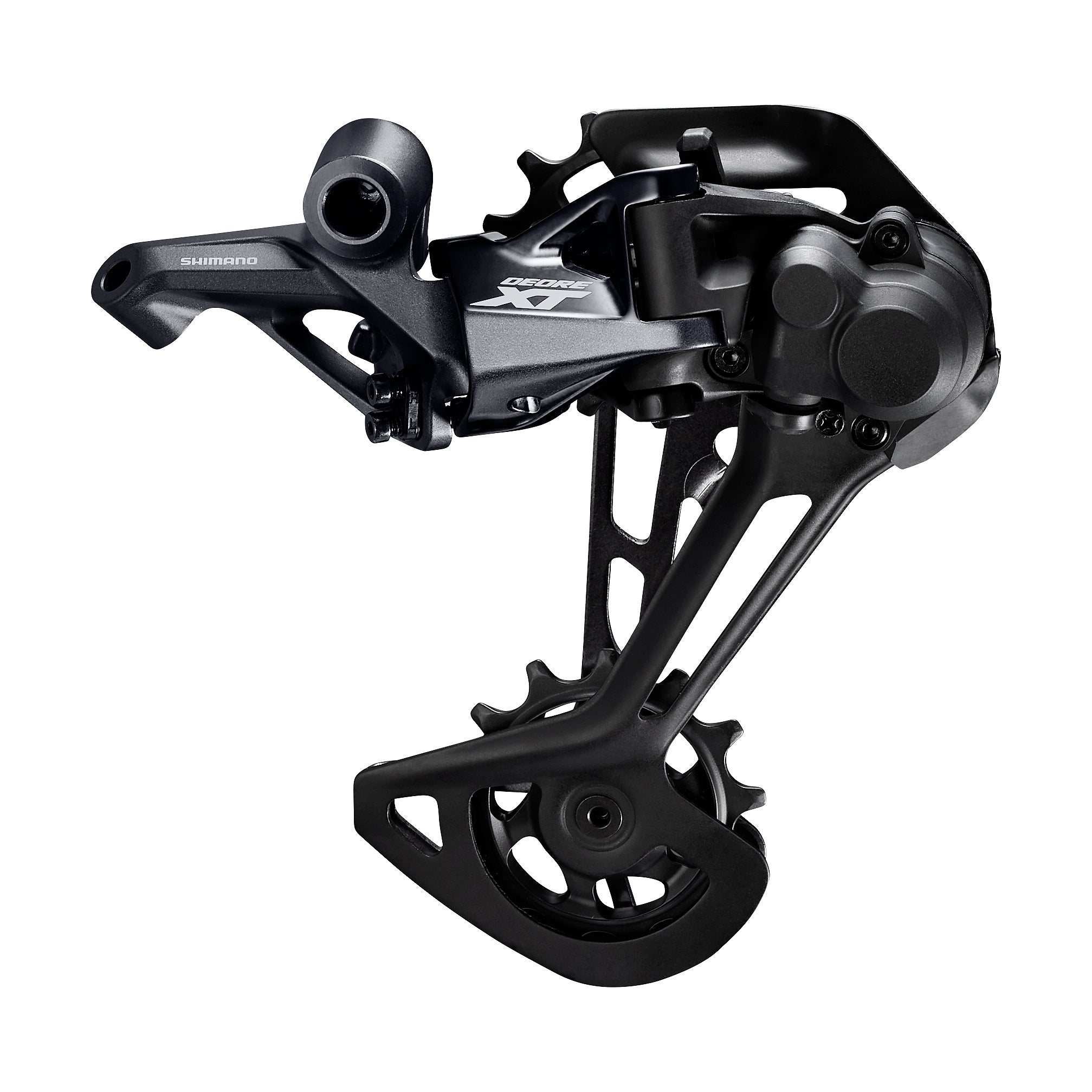 Photo Credit: Shimano
Photo Credit: Shimano
Deore XT, and many other Shimano derailleurs, use Shadow Technology. This design reduces the profile of the derailleur to keep it tucked away under the chainstay. This reduces chain slap in rough riding conditions and keeps the derailleur more protected from rocks and other objects in the trail that might damage it. Shimano claims Shadow Technology provides a smoother and more silent ride.
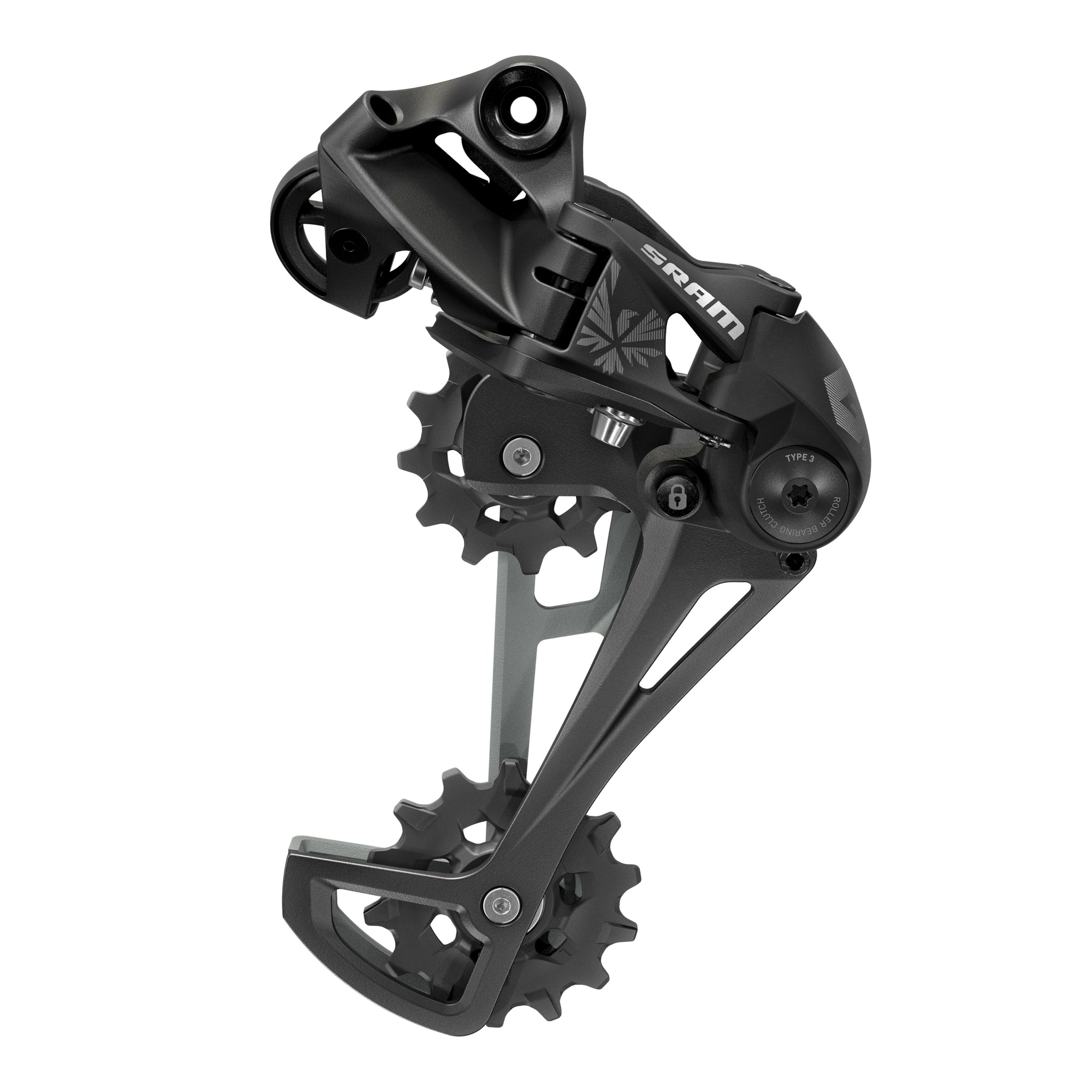 Photo credit: SRAM
Photo credit: SRAM
SRAM GX Eagle derailleurs are similarly tucked, and use SRAM X-Horizon and X-Actuation, which maintain an equal chain gap from pulley to cogs through every gear of a wide-range cassette. A “straight parallelogram” design also limits horizontal movement. SRAM claims this eliminates ghost shifts, reduces shift force, and maintains consistent shifting over the whole cassette.
Both Shimano and SRAM use a clutch to maintain chain tension and prevent dropped chains when riding through rough terrain. The Shimano clutch can be turned on and off. It has to be turned off to move the derailleur when removing the rear wheel. There have been plenty of times when I’ve forgotten to switch it back on — I didn't realize my mistake until I heard my chain slapping!
The SRAM clutch is always active. GX Eagle derailleurs use a cage lock that locks the pulley cage in a down position for removing the rear wheel.
The rear derailleur is worth discussing because it’s essential to your drivetrain function. Despite features like Shadow Technology that decrease the derailleur's profile, it’s still the mountain bike component that’s most vulnerable in a crash. If you're unlucky enough to lay your bike down and need to replace a derailleur, the Deore XT rear derailleur retails for $115, and the GX Eagle for $125. Pretty close.
Electronic shifting
SRAM recently unveiled a wireless electronic version of GX, GX Eagle AXS. It is more affordable than X01 or XX1 Eagle AXS, and it's currently the most affordable way to get an electronic 12-speed drivetrain on your mountain bike. Learn more in our GX AXS First Look article.
Currently, Shimano hasn't released an electronic Di2 version of its 12-speed mountain bike drivetrains. If it does, XTR will likely be first, with Deore Xt following sometime later. Until then, SRAM rules this space.
Popularity
The Pro’s Closet is the world leader in used bikes. Our employees love cycling, obsess over bikes and tech, and have access to a huge selection of products. They are all knowledgeable and opinionated so I polled riders in our shop to see which drivetrain they would choose if they had to pick between Shimano Deore XT M8100 and SRAM GX Eagle. We had over 50 respondents to this poll and many explained why they would pick one over the other.
The chart below shows the results.

Deore XT won out with our crew, earning two-thirds of the vote. Brand loyalty was a huge factor in this vote. Some riders explained they preferred Shimano because they have a reputation for refinement and are a 100-year-old Japanese company. Others prefer SRAM because they’re American and tend to have innovative ideas and products (like being first to market with a 1x MTB drivetrain and a 10-50t cassette).
Some riders are ex-roadies who have stuck with Shimano because they were the standard for road bike drivetrains. Others like SRAM because they were 1x early adopters who have now used SRAM for nearly a decade on their mountain bikes.
Only two respondents chose GX Eagle because of the slight weight advantage. Surprisingly, only one respondent mentioned the 10-51t Shimano cassette as a reason to choose Deore XT over a 10-50t SRAM option. No one mentioned the new 10-52t SRAM cassette. (Perhaps all the riders at TPC are so strong, they don’t care about the granny gear!) Even more surprising, only one respondent cared about price.
What I found really interesting was how voters on both sides had similar responses regarding feel. Many riders expressed a preference for the feel of one group or the other. Both Deore XT and GX Eagle voters used the words “buttery” or “crisp” to describe their preferred drivetrain while calling the other "unreliable" or “clunky.” Both Shimano and SRAM voters said their chosen drivetrain shifts smoother under power. Feel then, is truly in the eye of the beholder.
Reliability was also a big concern for several respondents. Both sides provided a few horror stories about parts going wrong or failing. But the vast majority of respondents said they “never had a problem” with either drivetrain and their thoughts on reliability were mostly based on anecdotes from the Internet or other riders. As far as I can tell from our small sample size, in real life, these two drivetrains are equally reliable.
In terms of aesthetics, four respondents said GX Eagle simply looks better. "I don't want that ugly two-tone cassette," said one GX voter. Unfortunately for Deore XT, no one praised its appearance.
Other small details drove decision making. Some don't like the on/off switch for the clutch on Deore XT derailleurs. Like me, they forget to turn it on or it becomes loose over time. Some can't handle the SRAM trigger shifters that don't allow you to upshift with your index finger (Shimano Rapid Fire shifters allow you to upshift with a push of your thumb or by pulling with your index finger). Some riders explained that they prefer Shimano or SRAM brakes and chose the drivetrain that matched their preferred brake. A few riders chose GX because they already had an XD Driver wheelset.
What’s the takeaway here? In our shop, the Deore XT supporters outnumber the GX Eagle supporters. The Deore XT and GX Eagle groups are both quality groups and personal preference and brand loyalty are the biggest deciders. Beyond price and weight, its the small details like a clutch lever, a color option, or even just a gut feeling that will sway most riders one way or the other.
[button]Shop Mountain Bikes[/button]
Compatibility
Shimano Deore XT Compatibility:
- Microspline Freehub: Shimano Deore XT M8100 12-speed cassette requires a rear wheel with a Shimano Micro Spline freehub.
- Chain and Chainring Compatibility: Deore XT M8100 uses a specific 12-speed chain designed for optimal shifting performance and durability with its drivetrain. If upgrading your bike to 12-speed Deore XT, you will at least need a new compatible chainring.
SRAM GX Eagle Compatibility:
- XD Driver Freehub: The GX Eagle 12-speed cassette requires a rear wheel with a SRAM XD Driver freehub.
- Chain and Chainring Compatibility: SRAM Eagle 12-speed chains work best for Eagle drivetrains. Most chainrings currently on the market are compatible with Eagle chains, unless they are designed specifically for Shimano 12-Speed chains.
What about the SRAM SX Eagle vs Shimano Deore?
Shimano Deore vs. Deore XT
The Deore groupset now features a 1x12 configuration, which provides a wide gear range for most trail riding scenarios. It will be slightly heavier than higher-tier options, but Deore delivers reliable shifting performance and decent build quality. It's often considered a reliable workhorse for riders who prioritize value for money without compromising too much on performance. XT components are built with higher-quality materials that are machined to decrease weight.
Ultimately, the choice between Shimano Deore and Deore XT depends on your preferences and budget. The Deore offers a solid performance-to-price ratio, making it an excellent choice for recreational riders and those on a budget. On the other hand, the XT groupset is generally the preferred option for more experienced riders who prioritize top-tier performance.
SRAM SX Eagle vs SRAM GX Eagle
The SRAM SX Eagle is positioned as an entry-level drivetrain option, making it more affordable and accessible to riders on a budget. It features a 1x12 drivetrain configuration with an 11-50t or 11-52t cassette, providing nearly the same wide gear range as a GX Eagle 10-50t or 10-52t cassette.
The SX Eagle incorporates SRAM's X-Actuation technology for precise and reliable shifting performance. But it uses lower-end materials so it is heavier and some riders find that shifts don't feel as crisp as GX and the derailleur itself seems less durable.
SRAM GX Eagle offers improved performance compared to the SX Eagle with SRAM's X-Horizon and X-Sync 2 technologies, which enhance shifting precision and chain retention, reducing the likelihood of chain drops. Many rider report that GX Eagle is more durable, shifts more smoothly, and is more reliable in tough riding conditions. While it may not have all the high-end materials and weight savings found in top-tier SRAM options, the GX Eagle strikes a good balance between performance and affordability.
The bottom line - SRAM SX Eagle is an entry-level option that offers decent shifting performance and a wide gear range at an affordable price. It's a suitable choice for riders on a budget or those new to mountain biking. On the other hand, the mid-range SRAM GX Eagle drivetrain provides improved performance and better durability compared to the SX Eagle. It's a popular choice for riders seeking solid shifting performance and increased reliability without totally breaking the bank.
Sram SX Eagle vs Shimano Deore
Overall, both SRAM SX Eagle and Shimano Deore have their strengths and weaknesses. If cost isn't a deciding factor though, the Shimano Deore drivetrain is generally considered superior to the SRAM SX Eagle drivetrain. It provides reliable performance and good value for money.
Final thoughts
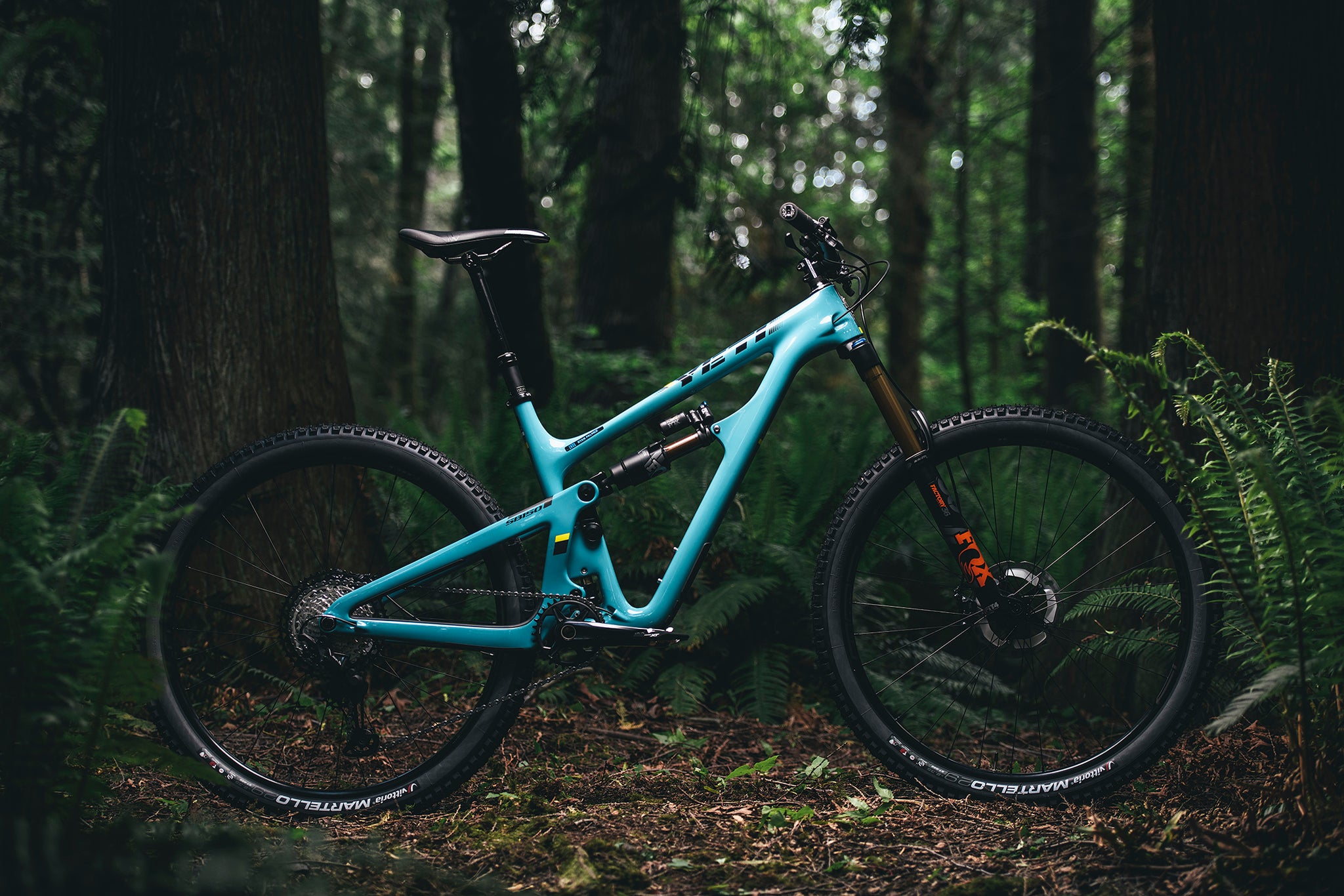 A glimpse into my future bike build. | Photo credit: Sterling Lorence
A glimpse into my future bike build. | Photo credit: Sterling Lorence
So what am I going to choose for my new mountain bike? In the poll, I voted for Shimano Deore XT. Why? Because I’ve owned and ridden several bikes with GX Eagle. My current bike has GX Eagle. GX has been around longer than Deore XT M8100, so it’s been easier for me to obtain bikes with GX over the last few years. But now, it’s 2020 and I’m looking to mix things up. Shimano's new 12-speed offerings are really exciting because they’re newer.
I have nothing but good experiences with GX, and would happily ride it again. But I’m not a super brand-loyal person, and I want to play the field a bit more. Hopefully, I can discover if I truly prefer one or the other.
Do you ride Deore XT or GX Eagle? Why do you think one is better? Or do you have another mid-level contender you prefer? Let us know in the comments!




